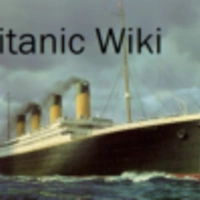Arthur Henry Rostron (May 14th, 1869 - November 4th, 1940) was best known for his role as Captain of the RMS Carpathia when the Titanic sank.
Titanic's CQD[]
Rostron had already sailed for 27 years, with the last 17 of them at the Cunard Line. He had only sailed with the Carpathia for three months on April 15. A few days earlier, they depared from New York bound for Fiume (now Rijeka, Croatia), and were scheduled to be stopping in Gibraltar, Liverpool, Genoa, Naples and Trieste.
But on Sunday night, at 12:18 A.M., Rostron was suddenly woken up by the First Officer and the Wireless Operator Harold Cottam. Rostron was about to scold them when Cottam said he had received a CQD from the Titanic. Rostron, known as 'The Electric Spark', ordered to change course immediatly and put the ship in the right diretion before asking confirmation from Cottam, other captains would reverse that. Cottam gave him the position and Rostron calculated they would need 4 hours to steam the 58 miles to the CQD-location. Then they went full speed ahead.
Next, Rostron prepared his whole crew for the recsue of the Titanic. he ordered:
- Chief engineer, to call another watch of stokers and make all possible speed.
- First officer, to knock off all work which the men were doing on deck, the watch on deck, and prepare all lifeboats, take out the spare gear, and have them all ready for turning outboard.
- English doctor, with assistants, to remain in the First Class Dining Room.
- Italian doctor, with assistants, to remain in the Second Class Dining Room.
- Hungarian doctor, with assistants, to remain in the Third class Dining Room.
- Each doctor to have supplies of restoratives, stimulants, and everything to hand for immediate needs of probable wounded or sick.
- Purser, with assistant purser and chief steward, to receive the passengers, etc., at different gangways, controlling our own stewards in assisting Titanic passengers to the dining rooms, etc.; also to get Christian and surnames of all survivors as soon as possible to send by wireless.
- Inspector, steerage stewards, and master at arms to control Carpathia's steerage passengers and keep them out of the third class dining hall, and also to keep them out of the way and off the deck to prevent confusion.
- Chief steward: That all hands would be called and to have coffee, etc., ready to serve out to all of Carpathia's crew.
- Have coffee, tea, soup, etc., in each saloon, blankets in saloons, at the gangways, and some for the boats.
- To see all rescued cared for and immediate wants attended to.
- Rostron's own cabin and all officials' cabins to be given up. Smoke rooms, library, etc., dining rooms, would be utilized to accommodate the survivors.
- All spare berths in steerage to be utilized for Titanic's passengers, and get all Carpathia's steerage passengers grouped together.
- Stewards to be placed in each alleyway to reassure Carpathia's passengers, should they inquire about noise in getting our boats out, etc., or the working of engines.
- Chief and first officers: All the hands to be called; get coffee, etc. Prepare and swing out all boats.
- All gangway doors to be opened.
- Electric sprays in each gangway and over side.
- A block with line rove hooked in each gangway.
- A chair sling at each gangway, for getting up sick or wounded.
- Boatswains' chairs. Pilot ladders and canvas ash bags to be at each gangway, the canvas ash bags for children.
- All lifeboats prepared and swung out.
To all Rostron strictly enjoined the necessity for order, discipline and quietness and to avoid all confusion.
At 2:40, he saw a flare, about half a point on the port bow, and immediately took it for granted that it was the Titanic itself, and he remarked that she must be still afloat, as he knew the Carpathia was a long way off, and it seemed so high.
However, soon after seeing the flare, Rostron made out an iceberg about a point on the port bow, to which he had to port to keep well clear of. Knowing that the Titanic had struck ice, of course he had to take extra care and every precaution to keep clear of anything that might look like ice.
At 3:45 A.M., he was reported everything was ready.
Rescue of the survivors[]
At 4:00 A.M., Rostron stopped the engines. They had reached the disaster site. Not in 4 hours, but in 3.5 hours.
At 4:10 A.M., he saw the first lifeboat. He wanted to get him alongside, but he had to dodge an iceberg.
At the US Inquiry, Rostron told what happened next.
- "We picked up the first boat, and the boat was in charge of an officer. I saw that he was not under full control of this boat, and the officer sung out to me that he only had one seaman in the boat, so I had to maneuver the ship to get as close to the boat as possible, as I knew well it would be difficult to do the pulling. However, they got alongside, and they got them up all right.
By the time we had the first boat's people it was breaking day, and then I could see the remaining boats all around within an area of about 4 miles. I also saw icebergs all around me. There were about 20 icebergs that would be anywhere from about 150 to 200 feet high and numerous smaller bergs; also numerous what we call "growlers." You would not call them bergs. They were anywhere from 10 to 12 feet high and 10 to 15 feet long above the water.
I maneuvered the ship and we gradually got all the boats together. We got all the boats alongside and all the people up aboard by 8:30.
I was then very close to where the Titanic must have gone down, as there was a lot of hardly wreckage but small pieces of broken-up stuff nothing in the way of anything large.
At 8 o'clock the Leyland Line steamer Californian hove up, and we exchanged messages. I gave them the notes by semaphore about the Titanic going down, and that I had got all the passengers from the boats; but we were then not quite sure whether we could account for all the boats. I told them: "Think one boat still unaccounted for." He then asked me if he should search around, and I said, "Yes, please." It was then 10:50.
I want to go back again, a little bit.
At 8:30 all the people were on board. I asked for the purser, and told him that I wanted to hold a service, a short prayer of thankfulness for those rescued and a short burial service for those who were lost. I consulted with Mr. Ismay. I ran down for a moment and told them that I wished to do this, and Mr. Ismay left everything in my hands.
I then got an Episcopal clergyman, one of our passengers, and asked him if he would do this for me, which he did, willingly.
While they were holding the service, I was on the bridge, of course, and I maneuvered around the scene of the wreckage. We saw nothing except one body."
They found one floating body of a crew member with a lifejacket, and they took 3 bodies from lifeboats, and one survivor died approx. 10:00 A.M. They were buried at sea.
Next, Rostron took as many lifeboats as he could on board Carpathia. Both emergency cutters were saved, and so were 11 of the 14 standard wooden lifeboats. Collapsibles C & D were left afloat, because D was sinking and Lowe had completely abandoned it. Rostron saw Collapsible B, still overturned. He never saw Collapsible A.
He kept cruising the disaster site for a half an hour. He started wondering where to go with his 706 unexpected passengers. They couldn't resume their original route to the Azores, they would run out of supplies before arriving there. Halifax was the nearest by, but the route was packed with ice and Rostron refused to give Titanic's survivors even more ice and a railway journey to New York. Returning the Carpathia to New York would be the most expensive option for the Cunard Line, but it would be the best choice for the survivors. Also, he knew that the route to New York had better weather than to Halifax.
About Stanley Lord[]
Captain Rostron seemingly wasn't very pleased with the actions of Captain Stanley Lord, the commander of the nearby Californian, who had taken no conclusions of his Officers' report on the white distress signals that they spotted during Titanic's sinking and didn't respond. He arrived on the scene very late after his telegrapher had finally heard the distress message that was sent at 6:00 A.M. in the morning. Rostron was quoted to have referred to Lord as 'the little man that didn't want to wake his wireless operator'.
Portrayals[]
A Night to Remember (1958)[]
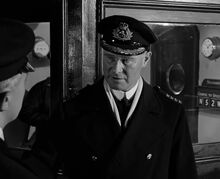
Anthony Bushell as Sir Arthur Rostron in A Night to Remember (1958)
In A Night to Remember, he was portrayed by Anthony Bushell.
S.O.S. Titanic (1979)[]
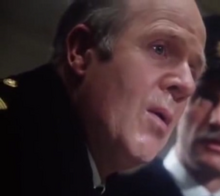
Phillip Stone as Sir Arthur Rostron in S.O.S. Titanic (1979)
In S.O.S. Titanic, he was portrayed by Phillip Stone.
1996 Titanic Miniseries[]
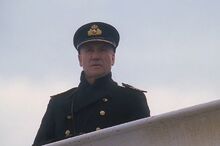
Terence Kelly as Sir Arthur Rostron in the 1996 Miniseries Titanic
In the 1996 'Titanic' Miniseries, he was portrayed by Terence Kelly.
'Titanic' (1997)[]
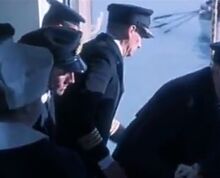
The only appearance of Sir Arthur Rostron in the 1997 Film Titanic
In James Cameron's 1997 blockbuster 'Titanic', he appears briefly in Carpathia's extended scene but that scene was cut. Because of that, his actor was uncredited.
Sources[]
- 'Titanic' ©1996 (second print, 1998) Edward P. De Groot
